Conclusions
-
1.
The alloy G75D25 possesses highly stable damping properties, the level of these not changing in the presence of cyclic overloadings (in the stress range σ=0.3–0.8 σ0.2).
-
2.
The brief cyclic overloading of steel 20 greatly increases its damping capacity, so that the energydissipation characteristics are comparable in magnitude with those of the highly damping alloy G75D25. The acquisition of considerable energy-dissipation capacity under vibration conditions by this steel is quite stable, and continues to hold on subsequent cyclical loading, even for stresses much smaller than the fatigue limit. This is an extremely valuable property from the practical point of view. since it increases the reliability of parts subject to chance or planned brief cyclical overloadings.
-
3.
The cyclical overloading (σ=0.8 σ0.2) of titanium alloy OT4 does not produce any marked increase in its original small damping capacity. At the same time there is a certain critical stress (σ=0.83 σ0.2) such that any cyclical overloads exceeding it are extremely dangerous, since they lead to such an intense heat evolution and self-heating of the sample that even for relatively low loading frequencies (200 cycles/min) premature fracture may occur, with partial fusion of the sample at the edges.
Similar content being viewed by others
Literature Cited
V. V. Matveev, B. S. Chaikovskii, and L. A. Bocharova, Probl. Prochnosti, No. 4 (1973).
M. E. Drits, L. L. rokhlin, and G. V. Ryuchina, Probl. Prochnosti, No. 6 (1972).
V. T. Troshchenko, Fatigue and Inelasticity of Metals [in Russian], Naukova Dumka, Kiev (1971).
V. V. Khil'chevskii and V. G. Dubenets, Probl. Prochnosti, No. 7 (1974).
V. A. Kuz'menko and A. D. Shevchuk, Probl. Prochnosti, No. 7 (1972).
G. E. Vizerskaya, Probl. Prochnosti, No. 11 (1972).
G. S. Pisarenko, A. P. Yakovlev, and V. V. Matveev, Vibration-Absorbing Properties of Construction Materials [in Russian], Naukova Dumka, Kiev (1971).
Yu. K. Favstov and Yu. N. Shul'ga, Alloys with High Damping Properties [in Russian], Metallurgiya, Moscow (1973).
G. S. Pisarenko and G. E. Vizerskaya, Damping Properties of Some Heat-Resistant Materials Subject to Extension-Compression Cycling at Normal and High Temperatures [in Russian], Naukova Dumka, Kiev (1972).
Yu. K. Favstov, S. E. Gurevich and A. P. Gaevoi, in: Fatigue and Rupture Toughness of Metals [in Russian], Nauka, Moscow (1974).
G. S. Pisarenko and V. T. Troshchenko, in: Questions of Mechanical Fatigue [in Russian], Mashinostroenie, Moscow (1964).
B. S. Shul'ginov, Probl. Prochnosti, No. 5 (1973).
S. E. Gurevich and A. P. Gaevoi, Zavod. Lab.,39, No. 9 (1973).
G. V. Gusev, Fiz. Met. Metalloved.,38, No. 1 (1974).
Additional information
Volgograd Polytechnic Institute, Volgograd. Translated from Problemy Prochnosti, No. 1, pp. 3–7, January, 1976.
Rights and permissions
About this article
Cite this article
Gur'ev, A.V., Mitin, V.Y. The stability of the energy-dissipation characteristics of various materials subject to cyclical (fatigue) loadings. Strength Mater 8, 1–4 (1976). https://doi.org/10.1007/BF01528202
Received:
Issue Date:
DOI: https://doi.org/10.1007/BF01528202




